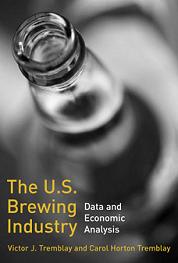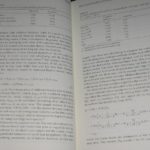 Like any member of the bar, I think a lot of myself. I think there are not too many documents I cannot wade through and conquer. I think I have met my match, not because it is too complex or on a topic that I cannot grasp but that it is in a language I have never come across before – economic analysis. The book’s full title in fact is The U.S. Brewing Industry: Data and Economic Analysis so I should have know. It’s that last word that gets me. You are trucking along in a chapter and, whammo!, mathematical formulae. It’s never the gaant charts or the flow charts or the pie charts or the multi-coloured graphs that get me – it’s the algebra. I think that makes what is called beeronomics econometrics. Click in the picture below and you will see what I mean.
Like any member of the bar, I think a lot of myself. I think there are not too many documents I cannot wade through and conquer. I think I have met my match, not because it is too complex or on a topic that I cannot grasp but that it is in a language I have never come across before – economic analysis. The book’s full title in fact is The U.S. Brewing Industry: Data and Economic Analysis so I should have know. It’s that last word that gets me. You are trucking along in a chapter and, whammo!, mathematical formulae. It’s never the gaant charts or the flow charts or the pie charts or the multi-coloured graphs that get me – it’s the algebra. I think that makes what is called beeronomics econometrics. Click in the picture below and you will see what I mean.
 But of course it is more than math that escapes me. Conversely, both authors are professors of economics at Oregon State University [Ed.: Go State!] and they explain their book in this way:
But of course it is more than math that escapes me. Conversely, both authors are professors of economics at Oregon State University [Ed.: Go State!] and they explain their book in this way:
Victor and Carol Tremblay have authored a book The U.S. Brewing Industry: Data and Economic Analysis, MIT Press, 2005. This represents the culmination of almost 25 years of research in which they analyze the important economic issues facing the brewing industry, 1950-2002. These include changes in demand and cost conditions, the causes and consequences of rising concentration, price, advertising, and other firm strategies, and the impact of advertising, excise taxes, and antitrust regulations on the economic performance of the industry. They focus on the macro or mass-producing brewers but also discuss the microbrewery and import sectors of the market. A unique feature of the book is that it provides a comprehensive dataset, including annual industry data on demand and cost variables (1950-2002), annual financial data from the 25 leading brewers (1950-2002), and annual production data from the leading 100 brewers (1947-2003).
For careful readers, you will appreciate this means the statistics pre-date the current craft brewing boom. Craft brewing is described but, as is concisely pointed out in the Introduction, we have to admit craft beer in 2001 accounted for 3% of total consumption – half a percent behind “ice beer”. No, this is not a book by boosters by boosters but the cold hearted results of 25 years of economic study brought together in one handy to describe the causes of industry concentration, basic cost issues, pricing and advertising strategies as well as public policy issues. That means it is a great over-view of the whole of the industry and could provide insight to craft brewers whose work now, by my reasonable guesstimate (not a concept in econometrics), now sits at about 4% to 5% of total beer consumption, eclipsing ice beer to stand maybe at half the importance of imports. I say guesstimate because I have not been able to find relative statistics in all the recent press about 31.5% growth in US craft beer sales over the three years ’04 to ’06. Nice to have access to a discussion of the economics of the industry that is made up of more than press releases.
So, am I glad I have this book? Definitely? Can I read it in one sitting? Not a chance. I think this is a book to get through gradually, to immerse myself in over a while – and also one to return to as a reference over and over. I expect it could serve anyone well, to give guidance both in relation to key elements of the industry as a base line for data…unless you happen to be an econometrician in which case you can zip through it during your next flight or maybe a lunch break.


 But of course it is more than math that escapes me. Conversely, both authors are
But of course it is more than math that escapes me. Conversely, both authors are